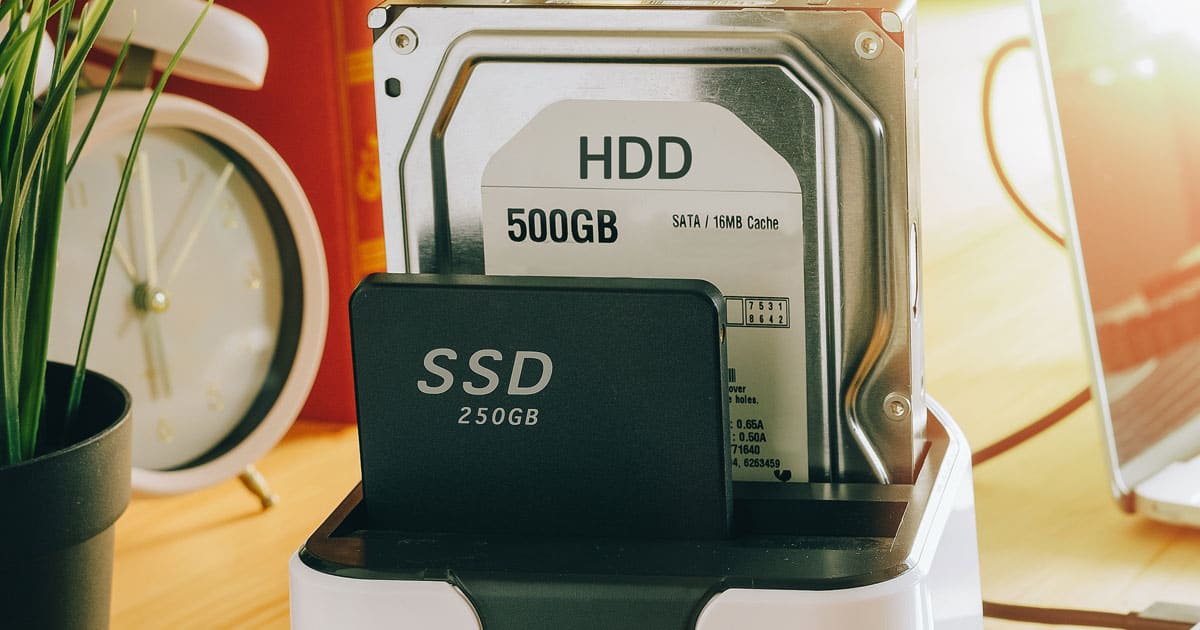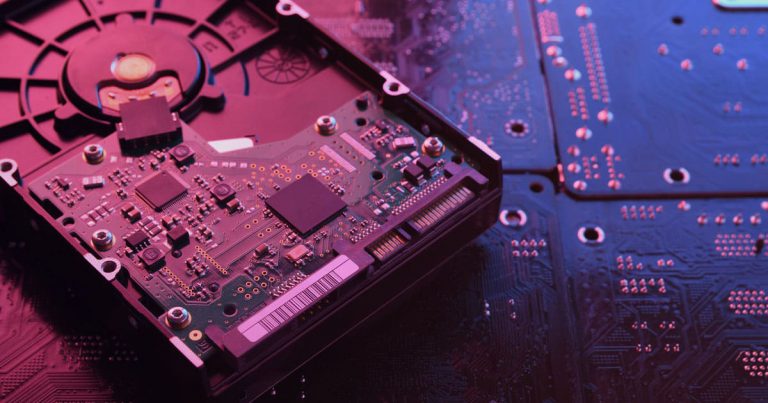What is a hard drive, and how do you choose the right one for you? In this article, we’re going to help demystify hard drive technology for those of you who aren’t familiar with it and make sure you have the information necessary for an informed buying decision.
Let’s begin.
What is an HDD (Hard Disk Drive)?
HDD stands for Hard Disk Drive, and it refers to the multitude of spinning disks that are present within a hard drive. Data is written to and read from these disks at a certain RPM (revolutions per minute), and that RPM determines the speed at which your hard drive can interact with the rest of your PC.
We’ll dive into more detail on RPM and other specs later on, but now you know the basics.
What makes it different from an SSD (Solid State Drive)?

An SSD, or Solid State Drive, is differentiated from a traditional hard drive because it does not have any moving parts. There are no disks, spinning or otherwise, present inside an SSD. Instead, SSDs use flash memory, which makes for much lower power consumption, heat exhaust, and size.
SSDs are much faster than HDDs, even those using the same SATA standard. Some SSDs even use NVMe or PCI Express speeds, enabling them to far exceed the limitations of traditional hard drives and the SATA standard. There are downsides to this, though, which we’ll explain at the end of the article.
Common sizes and recommended use
HDDs come in all different shapes and sizes, but nowadays your modern HDDs tend to be pretty big. And cheap!
Let’s list common sizes.
- Less than 500 GB – Not recommended for modern use. Will quickly reach capacity with regular game and media downloads. Will often be cheapest, but poorest value.
- 500 GB – Decent for modern use. Will still require users to be selective as to what they keep on their drive, but should work fine in most scenarios. Maybe cheap, but generally at poor value.
- 1 TB – Good for modern use. Should be great for frequent media downloads and game downloads, especially if one uses HEVC files to cut down on storage consumption. Cheaper than 2TB, but not a great value.
- 2 TB – Great for modern use. You’re unlikely to fill 2TB very quickly, and once you do fill it, chances are there’s plenty of unused stuff clogging up your hard drive. Also tends to be a great value.
- 3 TB – Superb for modern use. We’d be genuinely surprised if you filled this drive within two years of use, even with frequent game and media downloads. These tend to be the most expensive, but also offer the best value.
The difference between 3.5-inch and 2.5-inch hard drives
Oftentimes, you’ll see “3.5-inch” and “2.5-inch” measurements for hard drives. These measurements refer to the drive bay standard the drive will fit in, not necessarily its exact size or anything. (3.5 drives tend to be much bigger than 3.5 inches.)
3.5 drives are typically used by desktop PCs and server machines. 2.5 drives are generally used by laptop PCs and gaming consoles. 3.5 drives tend to have more storage at a cheaper price, and have a higher RPM (7200 RPM). 2.5 drives are more expensive for the same storage, and have lower RPM (5400 RPM).
Understanding hard drive RPM and speed
As we’ve alluded to before, RPM is a measurement of how fast the disks within the hard drive spin. These are the disks where data is written to and read from, so it stands to reason that faster is better.
It is. The major downside of buying a 2.5-inch hard drive over a 3.5 inch one is the speed that you lose in turn. However, SSDs are also available in 2.5-inch enclosures, and those are far faster than even the best 3.5 hard drives.
We recommend choosing a 2.5-inch SSD over a 2.5-inch HDD in any scenario where a 2.5-inch drive is your only choice. If you really can’t afford an SSD, you can also opt for an SSHD.
Understanding hard drive cache and SSHDs (Solid State Hybrid Drive)

In a traditional hard drive, you have a cache. It’s usually no larger than a few dozen megabytes, and it essentially serves as memory for the hard drive at large. SSHDs, or Solid State Hybrid Drives, take this cache and dramatically increase its size, usually into multiple gigabytes.
What this does is end up making the drive operate much faster than a traditional hard drive, especially when accessing frequently-used data. (Boot times, for instance, tend to be much faster when using an SSHD than with a traditional HDD.) While this still doesn’t reach a proper SSD in terms of speed, it is a fine compromise between the two technologies.
At the time of writing, Seagate FireCuda is the leading brand for SSHDs. If you want one, we recommend you go there.
The pros and cons of an HDD vs SSD
Now, let’s talk pros and cons!
- Pros
Cons - HDDs are far cheaper per gigabyte
HDDs are a lot slower than SSDs, especially NVMe or PCI Express SSDs - HDDs offer more storage space in general and are virtually identical when used for non-gaming media
HDDs are more vulnerable to physical damage than SSDs, thanks to the fragility of the spinning disks inside - HDDs generally won’t require an adapter of any kind when used in a desktop PC, since 3.5-inch bays are standard
HDDs are generally much larger and hotter than SSDs, which makes them less ideal for use in laptops, gaming consoles, and SFF PC builds
We’ve told you pretty much everything you need to know about hard drives, now. Making an informed buying decision should be pretty easy.
If you don’t feel like browsing for yourself, we’ll list a few of our favorite options below:
- Best Cheap HDD – Hitachi Ultrastar 750GB
- Best 1TB HDD – Seagate Barracuda 1TB
- Best 3TB HDD – Seagate Barracuda 3TB
- Best 2.5 Inch SSHD – Seagate FireCuda 2TB
- Best 3.5 Inch SSHD – Seagate FireCuda 2TB (3.5 Inch)
